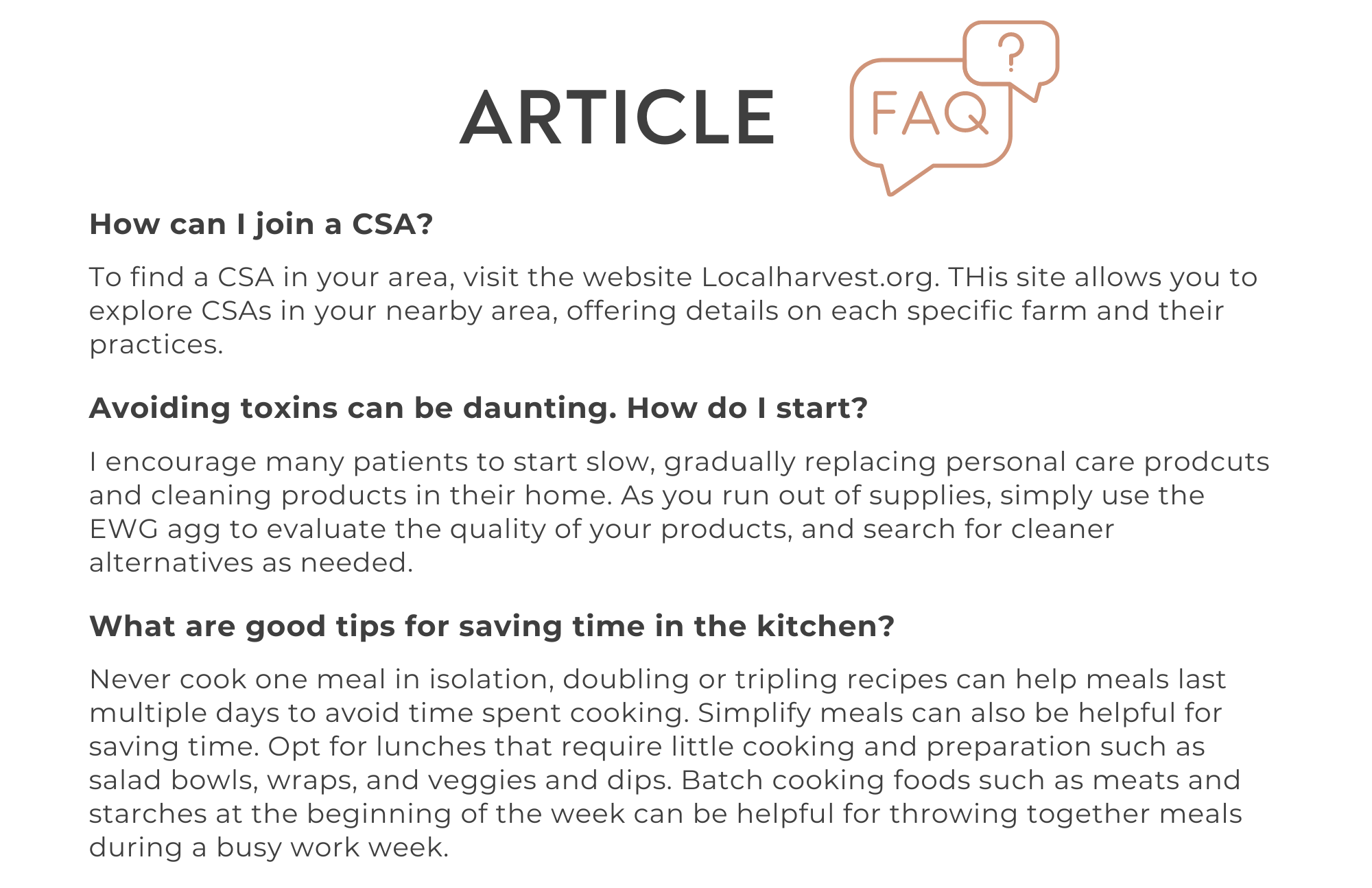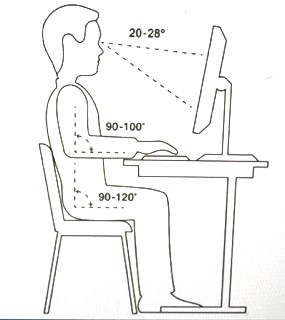

 919-999-0831
919-999-0831



Ergonomics
Ergonomics is the study of people’s efficiency in their work environment. The position of your monitor, how you sit, how long you sit, and many other variables can affect your work efficiency. It is also important to consider the impact that working in front of a computer can have on your mental and physical health. Here are several suggestions for making your work environment more productive, enjoyable, and healthier.
Computer and Visual Ergonomics
Mental and Physical Health
Call our office and schedule and appointment with one of our Health Coaches to learn more about ways to support a healthy mind and body while managing a robust work schedule.
Yours in health,
Clarissa A. Kussin, ND, FMHC, ERYT-1000

References:
1. Long J, Richter H. The pitfalls of the traditional office ergonomics model in the current mobile work environment: Is visual ergonomics health literacy the remedy? Work. 2019;63(3):447- 456. doi:10.3233/WOR-192937
2. Randolph SA. Computer Vision Syndrome. Workplace Health & Safety. 2017;65(7):328-328. doi:10.1177/2165079917712727
3. Chantal Coles-Brennan. Management of digital eye strain. Clin Exp Optom. 2019;102(1):18-29. doi.org/10.1111/cxo.12798
4. Dempsey PC, Larsen RN. Benefits for Type 2 Diabetes of Interrupting Prolonged Sitting With Brief Bouts of Light Walking or Simple Resistance Activities. Diabetes Care. 2016 Jun;39(6):964-72. doi: 10.2337/dc15-2336
5. Peddie MC, Bone JL. Breaking prolonged sitting reduces postprandial glycemia in healthy, normal-weight adults: a randomized crossover trial. Am J Clin Nutr. 2013;98(2):358-366. doi:10.3945/ajcn.112.051763
6. De Couck M, Caers R. How breathing can help you make better decisions: Two studies on the effects of breathing patterns on heart rate variability and decision-making in business cases. Int J Psychophysiol. 2019 May;139:1-9. doi: 10.1016/j.ijpsycho.2019.02.011.

 |
| “Lack of activity destroys the good condition of every human being, while movement and methodical physical exercise save it and preserve it.” — Plato Being consistently active helps you to live longer, have a better quality of life, improve your mental health, and improve your self-image. Take charge of your mental and physical health in only a few minutes a day. You can make big improvements to your health and energy levels by making small and deliberate healthy lifestyle choices that involve moving more every day. Many people feel daunted by the thought of changing their lives and starting a new routine to be more active, but there are only a few key tips to remember to be successful: Emphasize Fun. What is something you love? Whether that’s music, birds, friends, trampolines, or books, you can shape your activity plan around the things you love. Walk to and from a spot where you can listen to the birds every day; explore local libraries from top to bottom; take the stairs when you visit friends; take a dance class that incorporates music you love. Make the things you love part of your activity plan. Attach Activity To Habits. Taking a walk after dinner is a time-honored way to get moving. What is something you do regularly? Whether it’s going to work, cooking dinner, getting the mail, or brushing your teeth, any habit can be an opportunity to move. Try doing a one-minute wall-sit every time you brush your teeth; or practice dance steps while cooking dinner; or lift your bag over your head every time you go into your house. Any routine behavior can have a small activity bonus built in. Involve Others. Chances are, your friends, family, and co-workers want to be more active, too. Set active living goals together, see if you can aim for incremental advancements and variety in your routines. You could walk an extra two miles a week—or three more flights of stairs. When you meet someone who shares your activity goals, keep moving. Swap sitting at the coffeeshop for walks, and go around the block while catching up. Add Audio. Most phones can play music or podcasts, so challenge yourself to walk for at least one song, or one podcast. Having pleasant audio input can make exercise more fun and rewarding. Be Inventive. Rather than thinking of movement as calisthenics or a workout, challenge yourself to be inventive with your active living. Do an extra lap around the grocery store. Stand while watching a television show, instead of sitting. At work, think about how you can add a few minutes of movement by parking further away, or getting off the bus early. Whenever you text someone, stretch one part of your body. When you open the door at home, do a little dance. When you talk on the phone, stand up for part of the call or go for a walk and cover some miles with company. Be Forgiving. If you have a sedentary day, let it go. Don’t overwork the next day or punish yourself—just try to be active every day! Encourage yourself the way you would encourage your best friend. It is about progress, not perfection. Track your progress. Consider using a pedometer app on your phone, or truly dialing in with that Fit Bit you wear. The Oura Ring is a valuable option. How many steps do you take on an average work day? How many do you take on the weekend? Striving for 10,000 steps a day is recommended. However, some is better than none. See how it goes. Daily movement reduces the risk of many health conditions— protect your health! If you already have a condition, movement reduces the symptoms. Research shows that movement helps with conditions across a broad range: Many forms of cancer Depression, stress, and anxiety Cardiometabolic diseases including prediabetes, diabetes, hypertension, stroke Musculoskeletal health, including osteoporosis and rheumatoid arthritis. “Walking: the most ancient exercise and still the best modern exercise.”— Carrie Late Your Partner In Health! Clarissa A. Kussin, ND, RYT-500 |

 |
| Meditate on your feelings to get calm, grounded, and healthy.Our emotions can hold us hostage when their stormy winds of intensity and disharmony blow through the body. For example, when you’re angry, your belly can tighten, your heart might pound, and agitating thoughts can plague you for minutes, hours, or even days. This is because emotions, be they angry, peaceful, anxious, sad, or happy, activate your nervous system to release chemicals into your bloodstream that can pull your focus and energy away from other matters. When emotions are that strong, we may be tempted to label them the “enemy.” But refusing to accept how you feel only postpones the inevitable; every emotion you deny will always return, trying to convey important information. In a world full of stress and demands, rest is one of the most important factors for creating wellness. Restorative activities can include mental, physical, and/or emotional activities that help to promote resilience. Particularly if you are under chronic stress, restful activities can break the cycle of stress and assist you on the path to health. Get Unstuck Knowing that the brain is not static, but instead has plasticity, underlines one of the key reasons to practice restful habits: you can learn to be healthier, happier, and more connected. Focusing on the process of restoration, rather than current complaints or states, allows you to take charge of your own health and wellness. You can become more resilient and healthier. The Right Activities Many people turn to television, alcohol, or other semi-harmful activities to counteract stress. Replacing even a few minutes a day of those activities with ones that scientifically promote healing and restoration can trigger lasting improvements. Restoration activities like meditation, guided imagery, breathing techniques, gratitude, and mindfulness are time-honored, science-backed ways to make a difference internally. They have calming effects not only on the state of mind, but also helping to balance hormonal and immune function. Don’t let stress run the show. Select a restoration activity and see if it works for you—whether that’s finding something to feel grateful about every day or trying a new yoga pose. Be intentional and open. Take back a few minutes a day of your life, balance your emotions, and your health and wellness will follow. Restorative Activities Meditation Gratitude Journaling Deep breathing and breathing techniques Guided Imagery and/or Visualization Massage, Sauna, or Water Therapy Mindful Eating, Walking, or Body Scan Many others! A wide variety of conditions are assisted by restoration therapies, including: Anxiety, depression, and mood disorders Cancer Chronic pain and fibromyalgia Gastrointestinal disorders Sleep disturbances and stress disorders Heart disease, diabetes, and hypertension Hot flashes Asthma Emotions are messengers, here to deliver information about empowering actions you need to take in your life and relationships. Just as it takes time to strengthen muscles, it also takes time to strengthen your ability to welcome and respond to your emotions, rather than avoid them. Lean on them to find creative solutions and successfully navigate life. Your Partner In Health! Clarissa A. Kussin, ND, RYT-500 |

It has never been easier to connect with someone on the other side of the world, yet it’s so easy to feel disconnected from the people closest to us. We have more tools than ever to simplify tasks and accomplish more things quickly, yet our to-do lists have never been longer. Life is short, and time flies, especially in today’s fast-paced world.
These exercises are meant to help you slow down, enjoy life, and focus on the most important parts of your day. Take the time to prioritize daily objectives.
By focusing on the most important tasks to get done, we eliminate the hustle and stress of trying to accomplish everything at once.
Cut personal Internet use by half.
Technology has become a major element in most of our lives. Social networking, email, and web-surfing can occasionally cause our minds to lose focus and wander through hundreds of topics, thoughts and ideas.
Try to use half your designated Internet time to explore new hobbies, exercise, or meditate.
Enjoy nature.
When time permits – take a five to ten minute break to step outside and breathe in some fresh air. Disconnect from the rest of the world and concentrate on the beauty of nature.
Eat slower.
A lot of us tend to speed through meals – missing the chance to appreciate different textures and flavors. Start to chew foods slower and distinguish new tastes, aromas, and consistencies.
Connect and make time for yourself.
Acknowledge and consciously thank yourself for taking care of YOU. When did you last spend valuable time with yourself? Take a night to find a new book, watch a favorite movie, try yoga, meditate, or cook a new recipe.
Give yourself more time.
Some of us like to stick to a tight schedule and plan all our daily events. Next time you’re jotting down new tasks in your planner, try to factor in a few extra minutes when estimating how long things will take. This will help you not rush through daily tasks.
Take the scenic route.
Next time you’re driving a somewhat long distance – try taking the scenic route. Driving through open fields, mountains, or viewing a city skyline can be very relaxing.
Sit for a moment with your eyes closed when you start your computer. Even just a few moments of meditation can set the tone for the rest of your day. Try to empty your mind and take deep breaths before jumping into your day’s tasks.
Remember your goals and aspirations.
Each morning when you wake up, take a few moments to think about your life goals and aspirations. Try to recall the milestones you’ve already made in your life, and your drive to achieve new ones. Try doing this for about five minutes before getting out of bed to start your day.
Take the time and share this with someone you love that may need some support in slowing down…
Your Partner in Health!
Clarissa Kussin, ND, RYT 500
Functional medicine is a science-based health care approach to assess, prevent and treat complex chronic disease.
![]() Learn More
Learn More
After a brief allergy test, you can begin sublingual immunotherapy (SLIT), or allergy drops under the tongue. No more allergy shots!
![]() Learn More
Learn More
Learn how to prepare for your visit and what to expect at your initial consultation and at your follow-up visits with our office.
![]() Learn More
Learn More